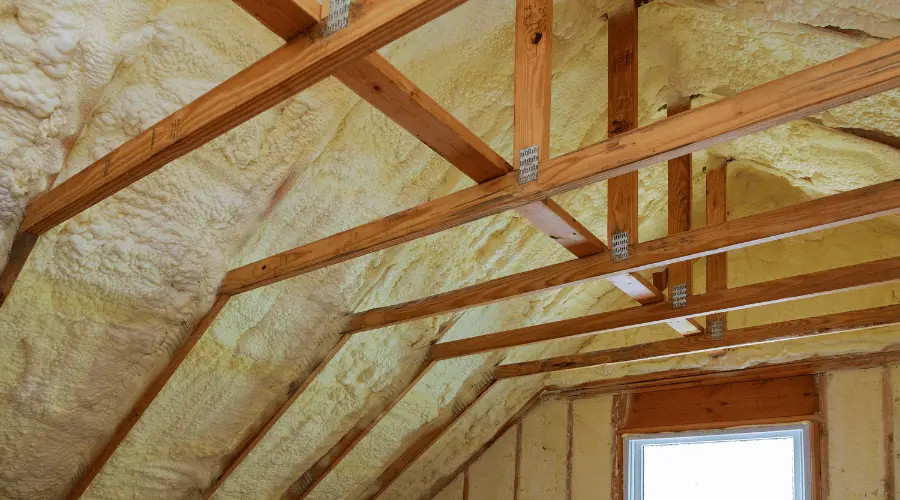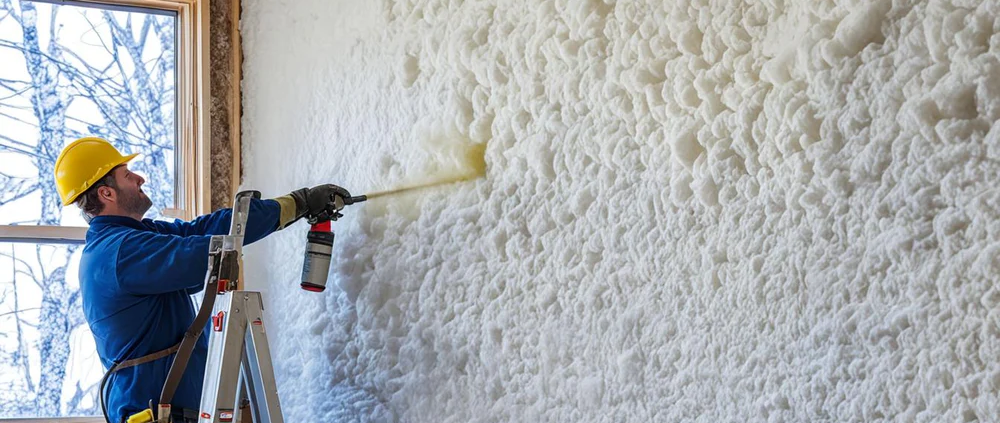Does Your Home Feel Drafty? Consider Modern Spray Foam Insulation
That persistent, chilly draft you feel near a window or along the floor is more than just a minor annoyance; it’s a clear sign that your home is losing a significant amount of energy and comfort. A drafty home is a direct result of air leakage, which happens when your insulation fails to provide a complete air seal. If your home feels drafty, modern Professional spray foam insulation is the most effective solution because it is the only common insulation material that also functions as a powerful air barrier. By expanding to fill every crack, gap, and crevice in your home’s structure, spray foam stops the uncontrolled air movement that causes drafts, leading to a more comfortable, stable, and energy-efficient indoor environment.
Traditional insulation materials like fiberglass and cellulose are designed to slow heat transfer, but they do very little to stop the movement of air. This article, with practical insights from local business owners and building science professionals, will explain where drafts come from and why spray foam is uniquely equipped to eliminate them for good.
The Science Behind a Drafty House
In a house, drafts are caused by air moving from one place to another due to differences in air pressure and temperature. The main culprit is a phenomenon known as the “stack effect.” In the winter, the warm, buoyant air inside your home rises. As it escapes through countless small leaks in your attic and upper floors, it creates a slight negative pressure in the lower levels of the house. This pressure pulls cold outside air in through leaks in your foundation, around windows, and through electrical outlets, creating the drafts you feel.
This constant cycle of air exchange has several negative consequences:
- Discomfort: Drafts make a room feel colder than it actually is, forcing you to turn up the thermostat.
- High Energy Bills: Your heating system has to work much harder to heat the cold air that is constantly being pulled into the house. The U.S. Department of Energy estimates that this can account for up to 40% of your heating costs.
- Poor Air Quality: The air being pulled in is unfiltered, bringing dust, pollen, and other outdoor allergens with it.
Why Traditional Insulation Isn’t Enough
Many homeowners are surprised to learn that their insulated home is still drafty. The reason is that traditional insulation materials like fiberglass batts and blown-in cellulose are not air barriers. Think of them like a wool sweater: they can keep you warm, but the wind blows right through them.
It is also extremely difficult to install these materials perfectly. Fiberglass batts must be cut precisely to fit around every pipe, wire, and electrical box, which almost never happens in reality. This leaves many small gaps that add up to a significant amount of air leakage. Blown-in insulation can settle over time, leaving the tops of walls completely unprotected. These gaps and the permeable nature of the material itself are why a traditionally insulated home will almost always be a drafty home.
Bonus Tip: A simple way to find major air leaks is to use an incense stick. On a cool, windy day, carefully hold the smoking stick near windows, outlets, and where the floor meets the wall. If you see the smoke being disturbed or pulled in a direction, you’ve found a draft.

The Air-Sealing Power of Spray Foam
Spray foam insulation is a completely different kind of material. It is applied as a liquid that expands on contact, filling every possible opening, no matter how small or irregular. It adheres directly to the wood framing, sheathing, and any penetrations, creating a single, continuous, and seamless air barrier.
This monolithic seal is what makes spray foam so effective at eliminating drafts. It stops the uncontrolled movement of air at its source. By sealing the leaks in the attic and the foundation, it breaks the cycle of the stack effect. The result is a home where the indoor air is stable, calm, and free from the chilly currents of air that make a space feel uncomfortable.
Comparing Draft-Stopping Abilities
| Feature | Fiberglass Batts | Blown-In Cellulose | Spray Foam Insulation |
|---|---|---|---|
| Air Permeability | High | High | Very Low (an air barrier) |
| Installation Gaps | Common around obstructions | Can settle, creating gaps | None; expands to fill all gaps |
| Effectiveness vs. Drafts | Poor | Fair | Excellent |
| Impact on Comfort | Prone to cold spots | Prone to cold spots | Consistent temperature |
Targeting the Biggest Sources of Drafts
While a whole-home insulation upgrade is the most comprehensive solution, a professional contractor can also use spray foam to target the areas that are responsible for the majority of a home’s drafts.
- The Attic: Because hot air rises, the attic is the “engine” of the stack effect. The single most effective way to reduce drafts is to air seal the penetrations in the attic floor or, even better, apply spray foam directly to the underside of the roof deck.
- The Rim Joist: This is the wooden perimeter that sits on top of the foundation in the basement or crawl space. It is notoriously leaky. Applying a few inches of closed-cell spray foam to this area can dramatically reduce the cold air that gets pulled into the home’s lower levels.
- Crawl Spaces: Unvented, uninsulated crawl spaces are a major source of cold, damp, and drafty air. Sealing the vents and insulating the foundation walls with spray foam can make the floors above much warmer and more comfortable.
Bonus Tip: Insulating and air sealing the rim joist not only stops drafts but also helps to protect the wooden structure of your home from moisture and pests that can enter through this vulnerable area.

Key Considerations for a Draft-Free Home
If you’re ready to solve your home’s draft problem for good, there are a few things to keep in mind.
- Airtightness Requires Ventilation: When you make a home very airtight, you must also provide a source of fresh, filtered air. This is typically done with a mechanical ventilation system, which is a much healthier way to breathe than relying on random, dirty leaks.
- Windows and Doors Matter: While the biggest leaks are in the structure, old, poorly sealed windows and doors can also be a significant source of drafts. An insulation upgrade should be part of a holistic plan that may also include improving these components.
- Professional Expertise is Key: Creating a complete air seal requires a deep understanding of building science. A certified professional will know how to apply the foam correctly and how to manage the ventilation needs of the newly tightened home.
Frequently Asked Questions
Can I just use caulk and weatherstripping to stop drafts?
Caulking and weatherstripping are great for sealing obvious gaps around windows and doors, and you should absolutely do it. However, this will not address the thousands of hidden leaks in your attic, basement, and walls that are the primary cause of the stack effect and a drafty house.
Which is better for stopping drafts, open-cell or closed-cell foam?
Both types of spray foam are excellent air barriers and will be extremely effective at eliminating drafts. The choice between them often depends on other factors. Closed-cell foam is also a moisture barrier and adds structural strength, making it ideal for basements. Open-cell foam is a better sound absorber, making it a great choice for media rooms or walls between bedrooms.
Will spray foam fix my cold floors?
In many cases, yes. Cold floors are often caused by drafts and heat loss through an uninsulated basement or crawl space. By insulating and air sealing the foundation and rim joist, you can make the floors on the main level significantly warmer and more comfortable.
Is it a messy process?
Professional installers are meticulous about preparation. They will cover all surfaces that are not being sprayed with plastic sheeting to protect them from overspray. After the job is done, they will perform a thorough cleanup.
A More Comfortable and Efficient Home Awaits
Living in a drafty house is uncomfortable and expensive. It is a constant reminder that your home is not performing as it should. By upgrading to modern Expert spray foam insulation, you can solve the root cause of the problem, creating a stable, comfortable, and highly energy-efficient home for you and your family to enjoy for years to come.
Get a Professional Home Comfort Assessment
The first step to eliminating drafts is to have a professional identify where the air leaks are and assess the condition of your current insulation. An expert can then provide a clear plan to improve your home’s comfort and efficiency.
The team at Armored Insulation is dedicated to providing top-tier service and has a deep understanding of the building challenges in our local community. They specialize in high-performance insulation solutions that make homes more comfortable and affordable to own. To schedule a comprehensive home assessment, they can be reached at (270) 727-5566 or by email at info@armored-insulation.com
Author: Jared Baker, Owner and Director of Business, brings deep local insight and strong business expertise to Armored Insulation as a native of Mayfield. While continuing a full-time role as a Staff Officer with a federal natural resources agency, he has successfully built multiple ventures, including Bluegrass Commercial Cleaning, Animal Tales, and Undercover Properties. As Armored’s Business and Marketing Manager, he plays a key role in upholding the company’s focus on delivering top-tier service.
Reviewer: Mia Clark used her 9 years of experience in spray foam to review this article and offered input focused on helping companies make their services easier to understand and market effectively.




Leave a Reply
Want to join the discussion?Feel free to contribute!